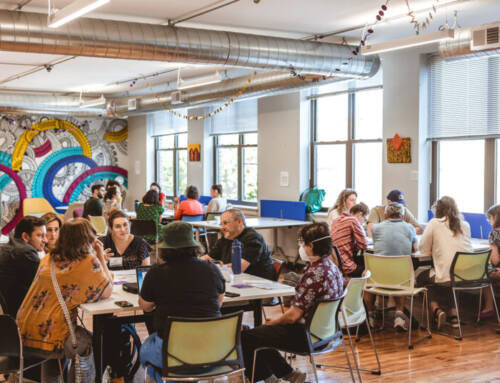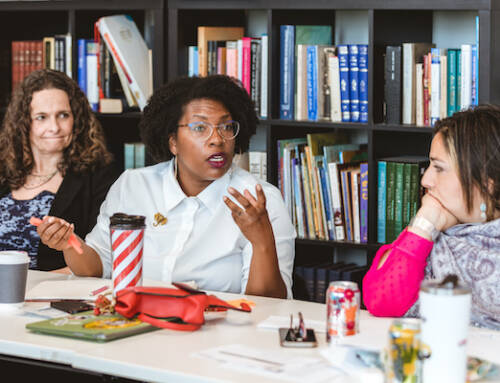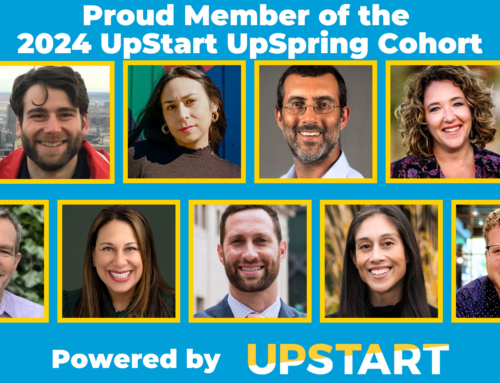by Maya Bernstein
When we begin to talk about new models, new structures, new leadership, new programs that replace the old, we inevitably have associations, and often those associations are negative.

The focus of the workshop was to help schools introduce World Language courses to their students in innovative ways. The day was designed to help the school teams arrive at prototypes they could take back to their schools. The kick-off activity was designed to help the teams develop empathy for their students, for whom learning a foreign language could be very daunting and challenging. It was led by Monica Martinez, the founder of Don Bugito Prehispanic Snaqueria. Thats right; the opening activity of the day was eating bugs.
Hows that for an icebreaker! Suddenly, everyone was immediately engaged. Ms. Martinez led us all outside, where there were two tables. One was full of normal food, like chocolate covered pretzels and nuts. These foods, though, were labeled bug names mealworms, moth larvae you get the idea. The next table had bugs in little paper cups, except that they were labeled real food names, chocolate covered pretzels, nuts, etc. She asked that when people eat the foods with which they were familiar, that they focus on the insect labels. Then, she asked that when we eat the insects, we focus on the familiar food labels. After the squirming and laughing and daring and double-daring, and eventually the eating, the group headed back into the workshop room to debrief.
We were asked to reflect on the experience itself, then to reflect on what it was like to be a learner challenged with a new and uncomfortable growth experience. We then moved into a brainstorming exercise on what elements we could translate from the experience to the challenge of teaching world languages. The group made wonderful connections, and the experience was the foundation upon which the rest of the days ideas were built.
As an observer of the activity (never have I been so happy to publicly announce that I keep kosher!), I was reminded of four core concepts that help to drive innovation and creativity:
Discomfort Drives Innovation
The reason this activity was so powerful was because it immediately pushed people into a realm of discomfort. The discomfort came from two places: preconceived notions that led to fear, and the unknown, the new. This discomfort, that combination of fear and the unknown, is highly generative. I couldnt help but think that, to my picky four-year-old, many vegetables are as frightening as those bugs. We are constantly pushing children to try new things new foods, new activities, new experiences. They are constantly right up against the edge of their comfort zones, and, if we provide enough scaffolding and support, are constantly growing, and ready to try the next challenge. That is the experience of learning and growth, and it is alive and exciting. And the products of those activities are often innovative, meaningful, and interesting. As adults, and, particularly in our work environments, we strive to avoid this type of discomfort, staying away from the fear zones, and veering towards the known and the comfortable. If we want to continue to grow, we need to create regular opportunities to tiptoe towards the new, and towards that which we fear.
Too Much Discomfort Shuts Down Innovation
When, though, there is too much discomfort, too much fear, too much new, or too much being asked of us beyond the boundary of our values and practices and beliefs, innovation is completely shut down. The icebreaker was lost on me. I was able to observe it, but I did not have those butterflies in my stomach (literally or figuratively) that so energized the other participants. It was simply too far outside of my personal zone of experimentation. This challenge of where to draw the lines that mark those boundaries is a particular challenge for the Jewish community. Where do we draw those lines? Who gets to draw them? We tend to err on the side of not pushing ourselves enough, lest we find ourselves eating bugs! Each organization and community should check in every once in a while, and draw out its boundaries. Where do we stand hard and firm? Where are we fully comfortable? And are we spending enough time right at the edge, pushing ourselves, not so far that we break the boundaries, but just enough that we are so alive, so engaged, so challenged, that we cannot help but grow?
Constraints Generate Opportunities
A group of folks who were less than enthralled about eating bugs gravitated towards me. Maybe they thought that by hanging out with me they were also somehow absolved from the activity. Before I knew it, I was engaged in a rich conversation about how I define kashrut and make it meaningful in my own life. Others began to open up about their connection to family and community and food. One woman shared her familys Jewish story, about how her grandparents kept kosher, and her father left it all and moved out west, how she grew up with very little exposure to Judaism, but is now sending her son to a Jewish preschool, and how he is bringing Judaism into their home. This, Im sure, was not an outcome the workshop organizers foresaw. Yet my constraint, keeping kosher, generated an opportunity for people to share personal stories, to connect around their relationship towards food and family and community, and to share their values and the choices those values dictated in their lives. In our group, we drew on this metaphor throughout the day as well.
Innovation Happens at the Intersection of the Old and the New
Innovation, by definition, is unfamiliar, and human beings are much happier in the space of the familiar. When we begin to talk about new models, new structures, new leadership, new programs that replace the old, we inevitably have associations, and often those associations are negative. We have an internal narrative that turns on, whether or not we are conscious of it weve tried that already, it wont work, its a bad idea, we dont have the funds for it, its too complicated, it will hurt someones feelings, etc. This is not unlike the narrative that we have when we think of eating bugs (kashrutaside) yuck, gross, disgusting. Part of the work of innovation involves re-writing that narrative. It involves turning the pre-conceived notions around the new idea from negative, to neutral, to positive. Theres something quite ingenious about calling the bugs the names of familiar, comfortable foods, and calling the familiar comfortable foods the names of the bugs. Is there an analogy in our community? Remember when synagogues were radical solutions way back, post destruction of the 2nd Temple? What would happen if we started thinking and talking about our synagogues as wildly innovative spaces, that pulled the core value of striving to connect to the divine from the ritual of sacrifices, and re-framed it as prayer? And what would happen if we referred to those radical new prayer communities, often perceived as so threatening to synagogues, as old-school communal gathering places, where Jews come together to connect to each other and to something greater than themselves?
Perhaps keeping these concepts in mind can help the new ideas, energy, and innovations our community needs go down the hatch just a bit more smoothly, and even become more palatable.
This article is cross-posted on eJewish Philanthropy.
Our purpose is to enable entrepreneurs to bring bold Jewish ideas to light. We help them reach Up to people in new ways that are meaningful, more inclusive, and create a brighter future for our Jewish community and the world we share.




